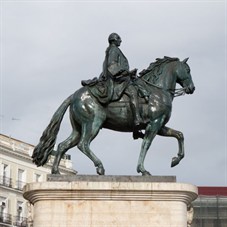Charles III of Bourbon
 Charles Sebastian of Bourbon (1716-1788) was the eldest son of the second wife of King Philip V of Spain, Elisabetta Farnese. Third in the line of succession to the Spanish throne, he saw himself guaranteed the inheritance of two Italian dynasties now close to extinction, the Medici and Farnese. He was the Duke of Parma and Piacenza and heir to the throne of the Grand Duchy of Tuscany from 1731 to 1735. In 1734, he led the Spanish troops to reconquer the kingdoms of Naples and Sicily, and was crowned king of the Two Sicilies in the following year. The conquest was ratified by the peace treaties that concluded the War of the Polish Succession (1733-1738), although Charles was forced to cede the states of the Medici to the Lorraine and those of the Farnese to the Habsburgs. His Neapolitan government ended when, in 1759, his half-brother Ferdinand VI died, and he ascended to the throne of Spain under the name of Charles III. As king of Spain he became the promoter of a reform policy, according to the model of enlightened despotism. In foreign policy, he sided with his French relative, Louis XV, in the Seven Years’ War, but getting serious losses.
Charles Sebastian of Bourbon (1716-1788) was the eldest son of the second wife of King Philip V of Spain, Elisabetta Farnese. Third in the line of succession to the Spanish throne, he saw himself guaranteed the inheritance of two Italian dynasties now close to extinction, the Medici and Farnese. He was the Duke of Parma and Piacenza and heir to the throne of the Grand Duchy of Tuscany from 1731 to 1735. In 1734, he led the Spanish troops to reconquer the kingdoms of Naples and Sicily, and was crowned king of the Two Sicilies in the following year. The conquest was ratified by the peace treaties that concluded the War of the Polish Succession (1733-1738), although Charles was forced to cede the states of the Medici to the Lorraine and those of the Farnese to the Habsburgs. His Neapolitan government ended when, in 1759, his half-brother Ferdinand VI died, and he ascended to the throne of Spain under the name of Charles III. As king of Spain he became the promoter of a reform policy, according to the model of enlightened despotism. In foreign policy, he sided with his French relative, Louis XV, in the Seven Years’ War, but getting serious losses.
Read more:
- C. Petrie, King Charles III of Spain. An Enlightened Despot, London 1971.
- F. Sánchez-Blanco, El absolutismo y las luces en el reinado de Carlos III, Madrid 2002.
- N. Guasti, Lotta politica e riforme all’inizio del regno di Carlo III. Campomanes e l’espulsione dei gesuiti dalla monarchia spagnola (1759-1768), Bologna 2006.
